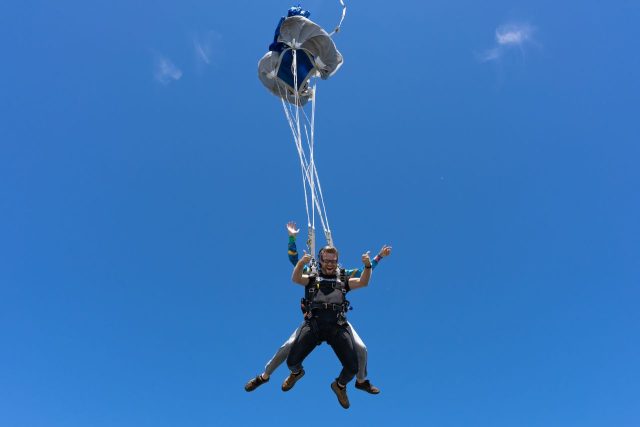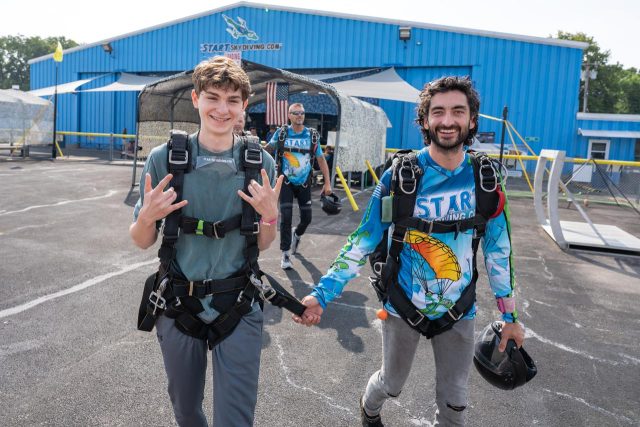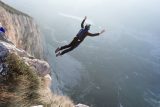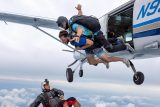Gear Up for Your Jump: Essential Skydiving Equipment Explained
Skydiving
Posted by: Start Skydiving
6 months ago
Skydiving is not just a thrilling adventure, it is also a sport that requires careful planning and the right equipment to ensure safety and fun! Whether you are a first timer or considering taking the leap into the world of skydiving, it’s important to understand what equipment is needed for skydiving. Without further ado, here is our ultimate guide to skydiving gear and equipment.

What Do You Need for Your First Time Skydiving?
If you’re gearing up for your first skydiving adventure, you won’t need to worry about purchasing any of the fancy parachuting equipment or wondering what to pack. At Start Skydiving, all necessary skydiving gear is provided with your purchase of a tandem skydive package.
Here’s a checklist for what you’ll need to wear and bring with your for your first jump:
- Comfortable Clothing
Opt for weather-appropriate, comfortable attire that is easy to move in. Avoid loose clothing or any clothing that may snag on the skydiving equipment (tassels, rhinestones, buttons, etc.). Athletic clothing that is form fitting and easy to layer if necessary is ideal for cooler temps up at altitude. Shorts are okay during the heat of the summer, however, we recommend wearing athletic pants when skydiving to keep your legs protected from the fast winds and the grass as you slide-in on your landing. - Closed-Toe Shoes
Protect those piggies! Athletic shoes that can be laced up tightly and cover the whole foot are an absolute must for a safe skydiving landing. - Identification
Bring a valid, government-issued photo ID (driver’s license, passport, etc.) and be prepared to fill out necessary paperwork when you arrive at the dropzone. - Positive Attitude
Your enthusiasm and sense of adventure are your best companions. Bring an open-mind, positive attitude, and be ready to experience the thrill of your life!

What Equipment Do You Need to Go Skydiving?
- Skydiving Jumpsuit
First things first, let’s talk about the iconic skydiving jumpsuit. The fashionable evolution of the skydiving jumpsuit has gone from baggy with bright colors and geometric shapes to sleek and form-fitting with bold block colors. While jumpsuits do indeed make you look good, it’s functionality reigns supreme.
Modern-day jumpsuits are specially designed to reduce drag during your freefall in order to fly more stable and enjoyable. Plus, they help protect your clothes from grass stains on landing, your skin from the 120 mph winds and do a pretty good job of keeping you cozy at higher altitudes.
- Parachutes
Your parachute gear is absolutely the heart of your kit. Skydivers jump with a dual parachute system – a main parachute and a reserve (back-up) parachute. The main parachute, or canopy, is your go-to wing, while the reserve parachute is your trusty back-up in case of emergencies. Reserve parachutes are to be repacked and inspected every 180 days regardless of whether or not they have been deployed and only by a certified parachute rigger.
- Skydiving Rig
The skydiving rig is that cool backpack-looking thing that skydivers wear. It is equipped with everything you need for a successful parachute deployment. The secure harness is what holds you into the system and the container is what holds the two parachutes and Automatic Activation Device (AAD). - Automatic Activation Device
The Automatic Activation Device (AAD) is the mini microprocessing computer that will automatically deploy the parachute at a certain altitude and speed should you (or the instructor) be unable to do so themselves for whatever reason.
- Altimeter
Ever wonder how skydivers know when to pull their parachutes? An indispensable tool called an altimeter! The altimeter is that watch-looking thing that skydivers wear on their arms, and its job is to calculate altitude by using the barometric pressures in the air. - Skydiving Helmet
If you’re a tandem skydiver, you won’t wear a helmet on your skydive. Here’s why… On a tandem skydive, you are strapped in front of your instructor. The potential of head-butting your instructor and potentially knocking them unconscious is much more risky than actually needing a helmet to protect your head from trauma!
Once you take on the student program, you will use a helmet not only to protect your noggin but also to communicate with your instructor via radio. Licensed skydivers also use helmets as a secure spot for their audible altimeter, keeping tabs on their altitude while their busy fun flying through the sky with friends. - Goggles
Skydiving goggles aren’t just cool eyewear; they’re essential for protecting your eyes from the fierce wind. Designed to fit snugly over your eyes (and glasses), these goggles ensure you have a clear view during freefall. No squinting necessary! - Gloves
If you jump where the sun’s always shining, you probably won’t need skydiving gloves. But if you plan to jump into the fall and beyond in Ohio, you’re going to want gloves! On some days, you may even want to double-bag your gloves! Keeping your fingers warm and nimble is important for safe navigation from the sky to the ground.

When Should I Buy My First Skydiving Rig?
We’ll be honest, skydiving can be an expensive hobby, so purchasing your first skydiving rig can be a huge commitment.
If you’re just starting out, it’s common practice to rent skydiving gear from the dropzone as you journey through your skydiving license, or even as a newly licensed jumper. This allows you to get a feel for the sport; seek skydiving gear advice from skydiving instructors; peruse our shop and other gear stores to see what’s for sale; figure out what size parachute works best for you; and research all the different parachuting equipment brands out there before making a substantial investment.
As you gain experience and become more serious about skydiving, you may want to consider purchasing your own skydiving rig. Most dropzones include gear rental in the price of each student jump and offer gear rental for an additional cost even after you become a licensed skydiver. So, no rush – you’ll know when the timing is right!
Check out our FAQs pages for more information about tandem skydiving or learning to skydive. And if you’re ready to take the leap, book your first jump or sign up for your first jump course! We can’t wait to get you started on your skydiving journey. Blue skies!



